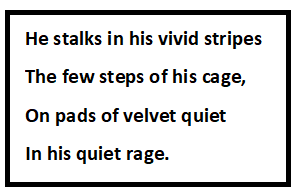Hi Everyone!! This article will share Tiger Questions & Answers.
This poem is written by George Leslie Norris. In my previous posts, I have shared the questions and answers of The Roadside Locksmith, Demosthenes and A Rupee Goes A Long Way so, you can check these posts as well.
Tiger Questions & Answers
Word Galaxy
- Stalks – follows slowly and quietly before attacking its prey
- Pads – the soft, fleshy part on the lower side of an animal’s foot
- Lurking – remaining hidden and quietly waiting before attacking someone or something
- Water hole – a pond or a lake in a jungle, where animals come to drink water
- Fangs – large, sharp teeth of animals
- Terrorising – frightening and filling with dread
- Concrete – a hard substance, made with cement
- Patrolling – going around a place to guard it
- Stalks – follows slowly and quietly before attacking its prey
- Pads – the soft, fleshy part on the lower side of an animal’s foot
Question 1: How does the tiger move about in his cage?
Answer: The tiger moves about quietly in his cage.
Question 2: Find a word in the first four lines that tells us about the mood.
Answer: The word in the first four lines that tells us about the mood is ‘rage’. It indicates that the tiger is angry.
Question 3: Why does the speaker think a tiger should go to a ‘water hole’?
Answer: In a jungle, water hole is a place where other animals come to drink water. at this place, the tiger can easily hunt its prey. However, in the zoo, the tiger doesn’t need to hunt. So, the speaker thinks that the tiger should be in the jungle so that it can do what it naturally does rather than waiting for someone to get its food.
Question 4: Is the tiger happy to see visitors at the zoo?
Answer: No, the tiger is not happy to see visitors at the zoo. We know this because it clearly ignores them and walks away.
Question 5: Read and answer the questions:

(a) What is responsible for the quiet rage of the animals?
Answer: When animals are kept in the zoos, they do not like it because they have to live within a small space. This is the reason for their rage. The tiger’s ‘quiet rage’ is caused due to its inability to get out of the cage so, it silently fumes with anger.
(b) Describe the image conveyed through velvet quiet.
Answer: The paws of the tiger are padded so as to give its tread the advantage of silence. The padded parts are velvet-like, soft and when it touches the ground, the sound is barely audible.
Question 6: Read and answer the questions:

(a) In which way is the description of the tiger in these lines different from what you have read earlier?
Answer: The earlier lines described the tragic and unfortunate circumstances of the tiger where it could not come out of the cage and is dependent on someone to get its food.
Here, the lines convey that how the tiger’s life should have been ideally in its own home, jungle.
(b) Why should he snarl round the houses at the jungle’s edge?
Answer: If the tiger was free in the jungle, he should be snarling round the houses at the jungle’s edge to terrorise the villagers rather than being captured by them.
(c) Why are the fangs and claws of the tiger mentioned?
Answer: The fangs and claws of the tiger depict the image that even though it is kept in the cage but it is still a ferocious animal and belongs to the wild.
Question 7: Where does the speaker feel the tiger should be? Does he approve of the concrete cell as a home for the tiger?
Answer: The speaker feels that the tiger should be in the jungle so that it can move freely and hunt its prey. No, he doesn’t approve of the concrete cell as a home for the tiger and believes that it should be snarling round the houses at the jungle’s edge to terrorise the villagers rather than being captured by them.
So, these were Tiger Questions & Answers.